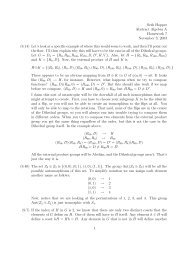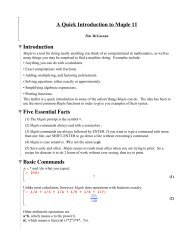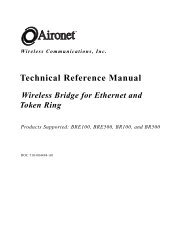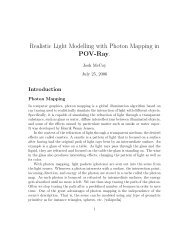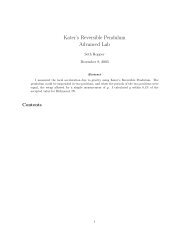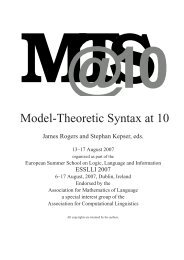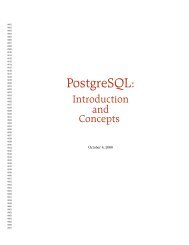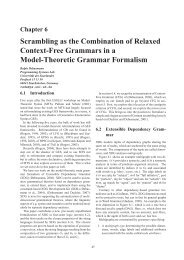The Use of Formal Language Theory in Studies of Artificial - CiteSeerX
The Use of Formal Language Theory in Studies of Artificial - CiteSeerX
The Use of Formal Language Theory in Studies of Artificial - CiteSeerX
You also want an ePaper? Increase the reach of your titles
YUMPU automatically turns print PDFs into web optimized ePapers that Google loves.
the <strong>in</strong>tended set if there are str<strong>in</strong>gs <strong>in</strong> the simpler set but not <strong>in</strong> the <strong>in</strong>tendedset that are not surpris<strong>in</strong>g.Pair<strong>in</strong>g AAABBB with AABBBB, for example, can reveal whether thesubject has generalized to A n B n or A i B j 2|(i + j) and provides evidence<strong>of</strong> be<strong>in</strong>g able to recognize str<strong>in</strong>gsets beyond the F<strong>in</strong>ite State. Pair<strong>in</strong>g it withAABBB, on the other hand, dist<strong>in</strong>guishes subjects that have generalized tothe strictly local str<strong>in</strong>gset A m B n , but fails to dist<strong>in</strong>guish F<strong>in</strong>ite State fromnon-F<strong>in</strong>ite-State; AABBB will be novel to both those that have generalizedto A n B n and those that have generalized to A i B j 2|(i + j).Pair<strong>in</strong>g AAABBB with AAAABBBB can reveal whether the subjecthas erroneously generalized to A i B i i ≤ 3. Although one can never ruleout the possibility that the subject has generalized to a f<strong>in</strong>ite subset <strong>of</strong> the<strong>in</strong>tended set that happens to <strong>in</strong>clude both the str<strong>in</strong>gs <strong>in</strong> the familiarization setand those <strong>in</strong> the discrim<strong>in</strong>ation set that are <strong>in</strong> the <strong>in</strong>tended set, one can be reasonablysure that they have not generalized to a f<strong>in</strong>ite set by <strong>in</strong>clud<strong>in</strong>g str<strong>in</strong>gs<strong>in</strong> the discrim<strong>in</strong>ation set that are longer than any <strong>in</strong> the familiarization set andtherefore unlikely to be <strong>in</strong> any f<strong>in</strong>ite generalization. Thus, failure to perceiveAAAABBBB as novel suggests that the subject has not generalized to anyf<strong>in</strong>ite subset <strong>of</strong> A n B n .F<strong>in</strong>ally, AABBBA or ABABAB will appear novel even to subjectsthat can recognize only strictly local str<strong>in</strong>gsets, although they will not appearnovel to a subject that has overgeneralized to |w| A= |w| B. Thus thesestr<strong>in</strong>gs fail to provide any evidence at all about the boundary between ContextFree and simpler str<strong>in</strong>gsets. <strong>The</strong> punch l<strong>in</strong>e here is straightforward: it iscritical to the validity <strong>of</strong> these experiments that we have a clear idea not only<strong>of</strong> the <strong>in</strong>tended str<strong>in</strong>gset but also <strong>of</strong> the str<strong>in</strong>gsets that it could, potentially, bemistaken for.Even with careful choice <strong>of</strong> stimuli there are still a variety <strong>of</strong> pitfalls <strong>in</strong>design and <strong>in</strong>terpretation <strong>of</strong> these experiments that must be avoided. Examples<strong>of</strong> utterances <strong>of</strong> English that satisfy the patterns <strong>of</strong> Fitch and Hauser(2004) <strong>in</strong>clude (1a), <strong>of</strong> the form (AB) n , and (1b), <strong>of</strong> the form A n B n . 5(1) a. {(d<strong>in</strong>g dong) n }b. {people n left n }c. {people who were left (by people who were left) n left}d. {people who were left (by people who were left) 2n left}5



